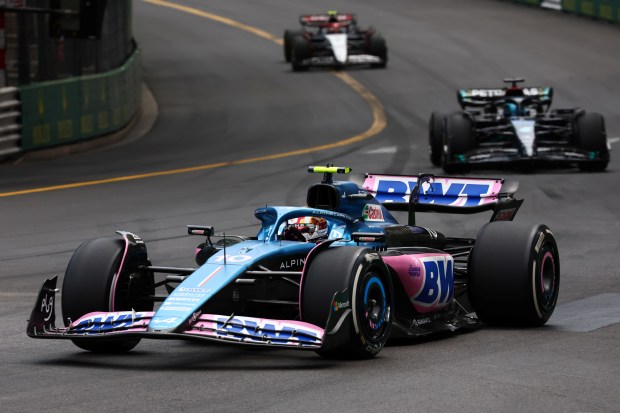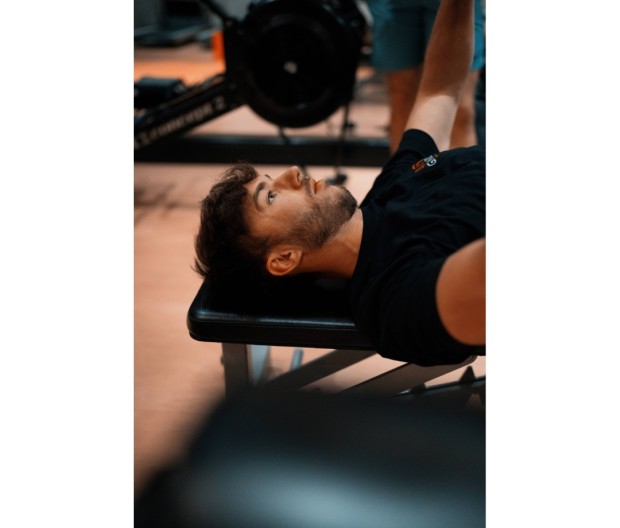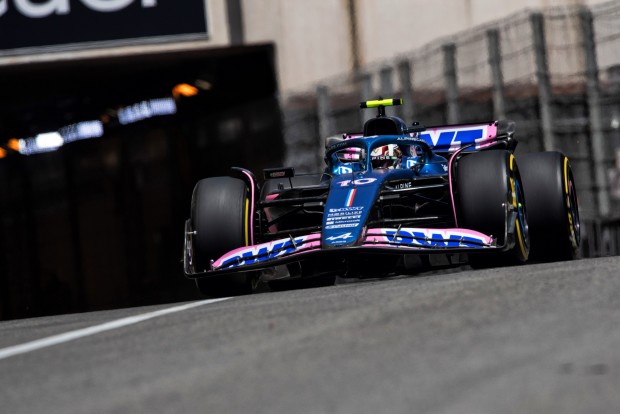Formula 1 has long been the most-watched motorsport in the world, and the “Netflix Effect” of Drive to Survive has only amplified its popularity. The dramatic increase in attention has augmented the competitive nature of a sport where 20 single-seat, open-wheel cars are piloted around purpose-built circuits and streets at speeds upwards of 186 miles per hour.
Given the level of competition for the 10 teams, and the complicated points system that holds them hostage, drivers are constantly looking for areas of improvement over the course of their eight-month season. Only adding to that pressure is the fact the top ranks are sometimes only separated by tenths of a second.
Pierre Gasly, a driver with Alpine Racing Team, thinks about those tenths of a second when he’s putting in work with his performance coach, Ben Thorne.
Related: Tom Cruise Did 13,000 Practice Jumps for Biggest Stunt Ever
“I’m looking for any possible advantage I can give my team,” says Gasly. “If that advantage can come from me having more endurance in the car or [being] quicker in turns, that's work I want to be doing.”
Getting those workouts in isn’t always easy, though, with a non-stop travel itinerary and the responsibility that comes with being one of the best F1 drivers to watch.
We met with Gasly to discuss how he trains for the circuit and sat in on his workout with Thorne to learn one of the most important exercises for a Formula 1 phenom.
Courtesy of Alpine
Men's Journal: What initially drew you in to the world of motorsports?
Pierre Gasly: I grew up in a big family, with four step brothers that were all into karting. My father was an endurance rally champion and my grandmother was a karting champion herself, so you could say it was in my blood. I got tired of staying on the sidelines, even as a kid, and I was six years old the first time I got behind the wheel. They had to put a foam pad on the seat so I could reach the pedals. I did three laps and I remember them clearly to this day. I was immediately taken in by the speed and the adrenaline. I was playing other sports at the time, but they all fell to the wayside when I found racing.
How has training enhanced your natural abilities as a driver?
The work Ben and I do in the gym is a huge benefit to my abilities. There's a lot of abuse on the body that comes during a Formula 1 season with being in the car for qualifying and the races, not to mention traveling on 100 or more flights to get to those tracks. As you can imagine, there’s a great risk of getting sick or injured, either of which could really affect the team.
But it’s not just the physical benefits. There's the mental benefit that comes from knowing I’m doing that extra little bit it takes to elevate above the competition. I want to come into each weekend knowing I've given everything I could—that I didn’t leave anything on the table. There’s a lot of competition and pressure in this world, which can be very taxing mentally.
Related: First Look: The Formula 1-Inspired Mercedes-AMG Project One
What specific muscle groups do you hone in on to withstand the demands of driving?
There's a lot of strain on your neck, arms, and shoulders when you're controlling a vehicle that's going up to 300 kilometers [186 miles] an hour. During some of the turns, we're experiencing 6 Gs [6 times the force of gravity] as we’re trying to hold positioning. That force can last up to a full second in some cases. Because of that, we have specialty exercises we do to build up power.
What are some unique challenges F1 drivers face compared to other sports?
The weight of drivers is regulated, so nobody has an advantage in terms of the overall mass of the car. Every driver needs to be a minimum of 80 kilograms [176 pounds], which was a rule that was introduced a few years ago. If we aren’t the minimum weight, then they have to add water to a ballast in the car. But the goal is also to not be too big, because the cockpit of the car is small, and too much weight is going to be a disadvantage. So, if you like training, especially strength training, then you have to be careful you're not getting too big. We work hard to find balance and make sure we’re staying on the fundamentals.
The surroundings I have to deal with are unique as well. For example, in Miami, there are hundreds of celebrities and athletes trying to come see everything up close. They’re walking through the garages and on the track, so you can find your eyes and arms being pulled in all directions. It takes a special degree of focus. But, at the end of the day, this is my work and this is my office. I’m showing up every day wanting to become the world champion. I know to achieve that I’m going to need a clear mind and a strong body to reach my ultimate goal.

Courtesy of Alpine
Given the amount of travel you do, what are some ways you're ensuring proper recovery?
The most important element is sleep in my eyes. I’m someone who is very sensitive to sleep. I need to get eight or more hours every night, especially going into a race weekend. There's also a lot of work we do to make the spaces we’re living in from week to week comfortable. I’m going from hotel to hotel, and I've become an expert in creating a space conducive to my success. I use the Oura Ring to monitor sleep and the quality of my recovery. I treat it as a game. Being a competitive person—I always want to win. So, every day, I’m trying to beat my high score and make sure I’m in the green.
What elevates your performance? How do you get into a flow state?
I think visualization is important, but I also think belief is as well. I truly believe I’ll win. t only that, but also that doing that extra amount will help me in the end. I don’t think this is a mindset that's exclusive to Formula 1. You need to have it to compete in any kind of sport at an elite level. That drive is then directed at being consistent in what I’m doing, no matter where I am and no matter how the circumstances might change. Our schedules and settings change almost every day, which is what makes that consistency so important. I give everything I have every day to achieve my dream of being a champion. These are not just career goals—they’re my life goals. I live for this. I feel lucky to have this kind of purpose in my life. Every single morning when I wake up I know exactly what my pursuit will be.
Related: How to Overcome Fear: Alex Honnold, Lindsey Vonn & More
Most of the world only pays attention to the big races on Sunday, but what does a full race weekend require from you as a driver?
On top of the physical training I’m doing, there's so much preparation that needs to happen to make sure we have the best race possible. [There are] so many testing laps and conversations with our engineering team to make sure the car is in the best situation. There's a lot of focus put on us drivers, but we don’t do it alone. Our best chance of victory is when everybody on the team is delivering 100 percent. I need to make sure I have that mental capacity to work with the team as well. The qualifying laps that happen on Saturday are very critical. I only have one lap to solidify my position, which can have a massive outcome for our races. So, despite the fact it’s only 60 minutes as opposed to the 90-minute race, it can still be very stressful.
What helps you get through the most grueling moments?
I enjoy those. I like those moments of competition against myself and my weaknesses. I want to push beyond those places others might give up. There are 19 other very good drivers who compete in Formula 1, and in that room I want go further than any of them would. I, Pierre Gasly, need to go past that line.

Alpine / Timo Ernst
Inside the Training of Formula 1 Driver Pierre Gasly
Performance coach Ben Thorne has worked with Formula 1 drivers for the past four years, and was connected with Gasly when the driver joined Alpine for the current season.
“Every driver in Formula 1 has similar challenges, including the amount of travel and the wear that spending hours in these cars can have on the body,” says Thorne. “That said, everybody is different in the way they deal with those challenges. The fact that Pierre enjoys working out and is hyper-focused when it comes to fitness definitely makes things easier for me.”
Given the constant change in location over the season, Thorne is careful to build a training program that Gasly can complete almost everywhere. As long as there's a rack of dumbbells, a bench, and a pullup bar, the duo are good to go.
On the road, Thorne will take basic pieces of gear like resistance bands, but he also has a good array of speciality pieces that are used specifically for what Gasly experiences in the car. This includes a neck-strengthening Gatherer Systems Harness and a light-up reaction drill from Blaze Pod.
Week at a Glance
For Gasly, race weekend starts on Wednesday, when the teams usually fly into their host city in the evening. The next morning, Thorne typically leads Gasly through a light workout to get the blood flowing and fire up the central nervous system before he meets with his engineers to discuss the latest as far as car performance.
“If I can get him to lift a little weight on Thursday, that’s a win, but since being on the track is so strenuous on the body, we don’t want to overdo it,” says Thorne.
These workouts comprise warmup drills like catching tennis balls and using the Blaze Pod system. Then Gasly warms up his neck with the Gatherer Systems Harness.
During the weekend, before Gasly gets on the track, Thorne will have him hit a quick session focused on mobility and activating the body.
According to Thorne, these drills not only help the driver activate his reflexes, but also help him refocus on the task at hand. “Pierre already has incredible concentration, but with the insane popularity that's come to the sport with Drive to Survive, there are a lot of distractions,” he says. “Getting to pull Pierre away from that madness, and have him dial in on one drill, helps him recenter among the noise.”
Following the race weekend, Gasly is right back in the gym almost immediately for a recovery session with Thorne that starts off with foam rolling on Monday.
Tuesday is probably the heaviest workout they do, including free weight exercises like the dumbbell bench press and dumbbell bench row to build power. From there, it’s time to start the process over again, flying into the next location in a process that will be repeated 23 times over the season.
“I would say that before the season begins is the only opportunity we have to really build because of how crazy the schedule is,” says Thorne. “Once the season starts, the major goal is to maintain the muscle mass he started with and see incremental improvements where we can. Pierre doesn’t mind working for those small advantages, whether it’s in the racing simulator or at the gym working on special elements like neck strength. That’s what makes him great.”
How to Train Like a Formula 1 Driver
Here’s an exercise that will give you neck strength like a Formula 1 Driver. This movement is included in the sessions Thorne does with Gasly before heading to the race track.
te: It takes some finessing to get the setup position right. Don't rush; ensure proper form and setup for safety. Stop immediately if you feel any pain.
Isometric Neck Bridge
3 x 10-second holds
How to Do It
- Start by sitting with your back against a bench, making sure to adjust its height so it's aligned with your neck, to start.
- Press the back of your head against the flat top of the bench, then step your feet out away from the bench—shoulder-distance apart. Your knees should be bent at 90 degrees, feet flexed, and heels digging into the ground.
- Brace your neck and trunk, then drive through your heels to bridge up to a full hip extension while simultaneously planting your feet. Maintain a straight line from ears to shoulders to hips. Only the top portion of your head should be on the bench; your neck is entirely off.
- Hold for 10 seconds, then return back to the seated position in a controlled manner. That's 1 set.
Catch the Belgian Grand Prix this Sunday on ESPN and find additional details on upcoming races on the Formula 1 website.

